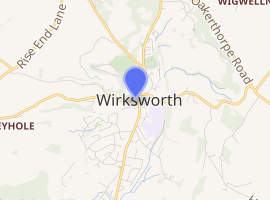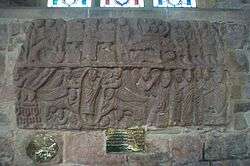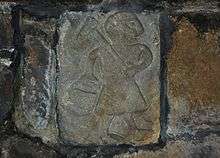St Mary's Church, Wirksworth
St. Mary's Church is a parish church in the Church of England in Wirksworth, Derbyshire. It is a Grade I listed building[2] dating mostly from the 13th century, but with notable survivals from the Anglo-Saxon period. It was restored in 1870 by Sir Gilbert Scott.[2]
| St. Mary's Church, Wirksworth | |
|---|---|
 | |

| |
| Country | United Kingdom |
| Denomination | Church of England |
| Churchmanship | Broad Church |
| Website | www.wirksworthteamministry.co.uk |
| History | |
| Dedication | St. Mary |
| Architecture | |
| Heritage designation | Grade I listed building |
| Designated | 24 October 1950 |
| Architectural type | Perpendicular Gothic |
| Specifications | |
| Length | 142ft[1] |
| Width | 102ft[1] |
| Administration | |
| Parish | Wirksworth |
| Diocese | Diocese of Derby |
| Province | Canterbury |
| Clergy | |
| Rector | Canon David Truby |
Description

The church is notable for its Anglo-Saxon carvings, and a large Anglo-Saxon coffin lid which was discovered in the churchyard in 1820. It is now mounted on the north wall of the nave. It appears to date from the second half of the 7th century.[3] The church is also noted for containing an Anglo-Saxon carving of a lead miner, "Th' owd Man", the oldest representation of a miner anywhere in the world. It was moved here in 1863 from Bonsall church for safe-keeping and has never been returned. The parishioners of Bonsall have had a replica carved for their church.[4]
It is one of the few remaining churches in Britain which still performs the ancient custom of clipping the church. This takes place on the first Sunday after 8 September, the Sunday after the Feast of the Nativity of the Blessed Virgin Mary.

Memorials
In the north aisle are the tombs of the Gell family. Sir Anthony Gell (d. 1583) has his statue on his tomb. Alongside is the simpler tomb of his father, Sir Ralph Gell.
The chancel contains the tomb of Anthony Lowe, a Gentleman of the Bedchamber who served Henry VII, Henry VIII, Edward VI and Mary I and died in 1555.
Abraham Bennet, the inventor of the gold-leaf electroscope and developer of an improved magnetometer.
The churchyard contains the tomb of Matthew Peat of Alderwasley, who died 11 December 1751, at an alleged age of 109 years and 10 months.[5]
Parish status
The church is in a joint parish with
- All Saints' Church, Alderwasley
- St James the Apostle's Church, Bonsall
- All Saints' Church, Bradbourne
- All Saints’ Church, Ballidon
- St James’ Church, Brassington
- St Margaret's Church, Carsington
- All Saints’ Church, Elton
- St James’ Church, Idridgehay
- Holy Trinity Church, Kirk Ireton
- Holy Trinity Church, Middleton-by-Wirksworth
Vicars
This list is taken from the list displayed by the South Porch door inside the church, except where noted otherwise.
|
|
|
Organ
In 1826 a two-manual organ was installed by Thomas Elliot. It cost £400 (equivalent to £33,856 as of 2019),[7] raised by subscriptions, and was placed in the tower of the church, but it was removed in 1853 to a more convenient location in the nave.
The church had a three-manual 26-speaking-stop tubular pneumatic-action pipe organ installed in the north transept in 1899 by Brindley & Foster.[8] It was rebuilt in 1955 by Kingsgate Davidson with electric action.
This organ was replaced in 1987 by a three-manual 48-speaking-stop Makin electronic digital organ.
Organists
- George Frederick Simms ????–1832[9] (afterwards organist of St Oswald's Church, Ashbourne)
- Thomas Reeves 1832–60[10]
- Edward Birch 1860–78[11]
- Nicholas Mason Day 1878–98[12]
- Carl Ashover 1899–1916[13]
- F. Isherwood-Plummer 1920[14]–1922 (previously organist of St Alkmund's Church, Derby)
- Edward S. Jones c. 1923–36
- Hingley James 1936[15]–????
- Harold Udall Ogdon
- Christopher Dixon 1980–present
References
- Hackett, Richard R. (1863). Wirksworth and five miles round. British Library, Historical Print Editions. ISBN 978-1241320706.
- Historic England. "Church of St Mary (Grade I) (1335090)". National Heritage List for England. Retrieved 28 July 2014.
- Millward, Roy; Robinson, Adrian Henry Wardle (1975). The Peak District. Eyre Methuen.
- The Matlock Mercury, 20 February 2002
- Magna Britannia: Volume 5: Derbyshire (1817), pp. 275–306.
- "Photograph of church records for 1412". Anglo-American Legal Tradition. University of Houston Law Center. Retrieved 9 January 2020.
- UK Retail Price Index inflation figures are based on data from Clark, Gregory (2017). "The Annual RPI and Average Earnings for Britain, 1209 to Present (New Series)". MeasuringWorth. Retrieved 2 February 2020.
- "Derbyshire Wirksworth, St. Mary, Church Street [N05363]". The National Pipe Organ Register. The British Institute of Organ Studies. 2008. Retrieved 9 January 2020.
- Derby Daily Telegraph, Monday 22 February 1932
- Wirksworth Advertiser 27 July 1860
- Derbyshire Times and Chesterfield Herald, Saturday 26 October 1878
- Plaque in church on pier in the north transept.
- Lichfield Mercury, Friday 18 February 1916
- "A Derby Organist's Appointment". Derbyshire Advertiser and Journal. 21 March 1920. Retrieved 3 June 2017 – via British Newspaper Archive.
- "New Choirmaster". Derby Daily Telegraph. England. 29 May 1936. Retrieved 3 June 2017 – via British Newspaper Archive.